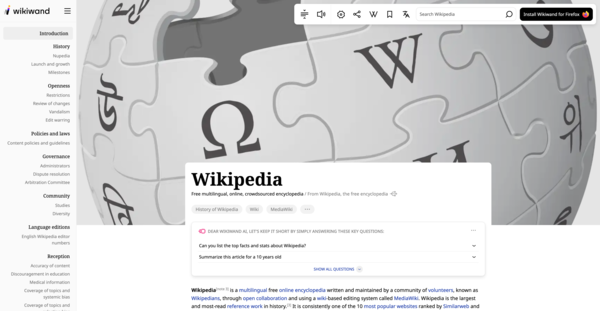Ever stumbled upon a Wikipedia page and thought, “Well, this could use a little sprucing up”? Enter Wikiwand, the slick interface overhaul that’s been quietly transforming the way we dive into the world’s largest encyclopedia.
If you’re always hunting for a more enjoyable reading experience or a quicker way to sift through mountains of information, then stick around. We’ll walk you through why Wikiwand is the facelift Wikipedia didn’t know it needed.
Introduction to Wikiwand
Wikiwand isn’t your average browser extension. It’s what happens when designers ask, “How can we make the ocean of knowledge that is Wikipedia not only more navigable but also easier on the eyes?”
Since its debut, Wikiwand has been on a mission to modernize the somewhat dated look of Wikipedia, making it more accessible and visually appealing. For example, look at American investor Sky Dayton’s Wikiwand page to see its user-friendly layout.
But what exactly sets it apart from the classic Wikipedia interface we’ve all grown accustomed to?
Key Features of Wikiwand
First off, Wikiwand takes the cluttered Wikipedia page and transforms it for modern readers. With improved typography, a fixed table of contents for easy navigation, and a layout that breathes, you’re looking at information in a way that’s digestible.
Ever got lost clicking through Wikipedia links? Wikiwand’s sidebar keeps you anchored, letting you hop between sections without losing your place. And for the visually inclined, it integrates images and videos more seamlessly, making those long reading sessions less of a slog.
It’s not just about looks. Wikiwand understands that we live in a personalized world. So, it lets you tweak settings to your liking, changing themes, and even how links are displayed. And while some may raise an eyebrow at the introduction of ads, it’s a small price for a significantly upgraded experience.
The Benefits of Using Wikiwand
Why bother switching, you ask? Imagine finding information faster, enjoying the process, and actually retaining what you read. That’s the Wikiwand advantage. It’s not just a cosmetic upgrade; it’s about making the vast resources of Wikipedia more usable. For students, researchers, or the just plain curious, it means less time digging and more time learning.
How to Get Started with Wikiwand
Getting on the Wikiwand bandwagon is a breeze. A quick visit to their website, a couple of clicks to add the extension to your browser, and voilà, you’re in business.
From there, it’s worth diving into the settings to personalize your experience. Whether you’re a dark mode devotee or someone who prefers their text a certain size, Wikiwand’s got you covered.
Future Prospects of Wikiwand
Looking ahead, Wikiwand seems poised to continue its trajectory of innovation. With user feedback shaping its evolution, it’s exciting to think about what features might be on the horizon. Could we see AI-driven summaries, even more, advanced customization, or community-driven content enhancements? Only time will tell, but one thing’s for sure: Wikiwand is changing how we interact with Wikipedia for the better.
So, next time you’re about to tumble down a Wikipedia rabbit hole, why not give Wikiwand a shot? It just might change the way you think about online research. And who knows, with tools like these making information more accessible and enjoyable to consume, we might all just end up a little bit smarter.
